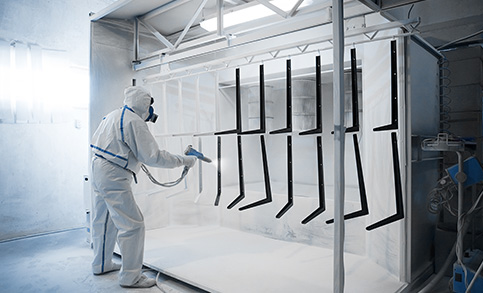In powder coating areas, high humidity causes improper particle deposition, irregular film thickness, operational problems in spray guns, caking or agglomeration (clustering) of the powder particles and has a measurable negative effect on powder resistivity. In severe cases, powders exposed to high humidity, cannot deposit at all.
Additionally, humidity has a direct relationship with ion charge decay, particle deposition, and regularity of deposited thickness. It may cause the powder particles to stick to the corona electrode and thus quench the corona.
General Recommendation
Relative Humidity in Powder Coating Areas should be maintained at 40+5% RH at 24+5ºC.
The Solution
Powder Coating have opened a new horizon in the product finishing industry all over the world providing the user improvements in coating quality, efficiency, and economy. Powder coating permits the paining of objects by spraying a dry product with no solvent, thereby avoiding pollution of water or the atmosphere. From an economical standpoint, overspray or excess powder can be reclaimed through a recovery system and reused.
The Process
Efficiency and reliability of Powder Coating is mainly a function of the compulsory control of the interactions between the product to be applied, i.e., its chemical composition and the various elements, such as charge decay of the equipment operating under the surrounding conditions of the application. Relative Humidity and temperature directly affects the practical application achieved. However, in most powder coating spraying facilities, these surrounding conditions are not controlled.
Bry-Air Solution
Utilization of Bry-Air Dehumidifiers and environmental systems accomplishes complete control over both relative humidity and temperature within the powder spray booth area and often the entire coating room.
The advantages stem from two basic points:
- Lower humidity will provide the ideal environment for the powder particles to sustain their charge prior to impact with the target
- Since most powders are hygroscopic to varying degrees, high humidity will cause agglomerates to form on the walls of the recovery duct, filters and tubing. The filter bay house becomes less efficient requiring frequent attention
Advantages
Up to 15% less powder is required – due to uniform control of film thickness and reduced losses from powder coating build-up and agglomerates.
Increased control over film thickness – by controlling the electrostatic field more precisely, the ability to coat the target more uniformly is achieved (particle deposition coupled with long term ion decay).
Increased system fluidising – the recovery system works nearer to its peak performance level due to reduced powder build-up in the duct, filter, and tubing.
Reduced Agglomeration – dehumidified air reduces the powder’s ability to adhere to the inside surfaces.
Reduced spray gun build-up – a noticeable, marked improvement in quality.













